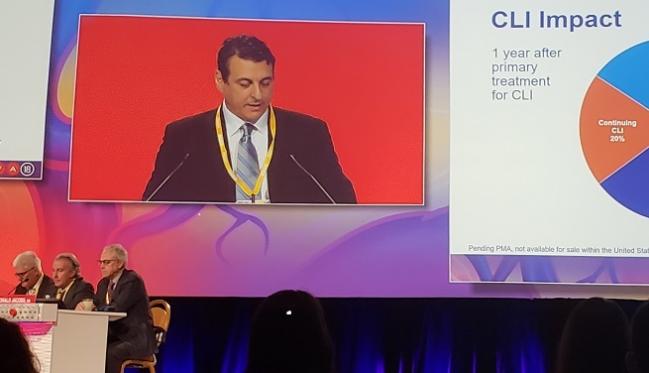LUTONIX BTK: Hope for Challenging Patients at High Risk for Amputation
Patients treated with the DCB had similar safety outcomes as those who received PTA, but limb salvage and primary patency were better at 6 months.

LAS VEGAS, NV—A global, randomized trial that enrolled a wide variety of patients with below-the-knee (BTK) lesions suggests that a drug-coated balloon (DCB) employing paclitaxel could stem the tide of limb loss that is all too common in this population.
“For the first time since the inception of therapy for [critical limb ischemia (CLI)] we have something that provides an almost 15% difference at 6 months in efficacy for DCB over [percutaneous transluminal angioplasty (PTA)],” said Jihad Mustapha, MD (Advanced Cardiac & Vascular Amputation Prevention Centers, Grand Rapids, MI). “This is a great breakthrough.”
Mustapha presented 6-month data from the Lutonix BTK Global DCB IDE study here today at VIVA 2018. The 442-patient multicenter randomized trial pitted the Lutonix 014 DCB (BD) against PTA in BTK patients with primarily Rutherford class 4 and class 5 CLI.
The primary safety endpoint was met, with no difference between the two groups in terms of freedom from major adverse limb events (MALE) and all-cause perioperative death at 30 days (99.3% for DCB vs 99.4% for PTA; P < 0.0001 for noninferiority) or at 6 months (97.8% for DCB vs 95.3% for PTA). The overall amputation rate was approximately 4% for the entire study population, Mustapha reported.
“Previously published DCB studies have generated concern regarding amputation rates with DCB use,” he noted, adding that “it is extremely important to put this safety issue to bed. You can use DCB in these patients.”
Additionally, the efficacy endpoint (a composite of limb salvage and primary patency at 6 months) was higher in the DCB arm compared with PTA at 6 months at 73.7% versus 63.5% (P = 0.0273 for superiority). According to Mustapha, the separation in the curves began at 30 days, suggesting that the DCB therapy may reduce the restenosis rate, which is often apparent by 6 weeks to 3 months after the initial PTA and frequently leads to amputation as a last resort.
DCBs Back in the Game on a ‘Bunt Single’
Panelist George Adams, MD (UNC REX Healthcare, Raleigh, NC), called the results “refreshing” for clinicians who treat these patients.
“This gives us something below the knee to actually make an effect on those patients that otherwise would not have had another modality to help with restenosis and with keeping that vessel open and ultimately healing the wounds.”
The study population, which consisted of patients who were randomized from 51 centers in the United States, Canada, Europe, and Japan, included a mix of long and complex lesions as well as patients with aggressive wounds. About 70% of patients each treatment arm had diabetes, most were hypertensive, and more than half in each group were smokers. Mean lesion lengths were longer in the DCB arm than the PTA arm (111.8 mm ± 92.6 mm vs 94.7 mm ± 85.4 mm). Mean reference vessel diameters were 2.5 ± 0.6 mm and 2.6 ± 0.6 mm, respectively. More than half of all lesions in each arm were calcified, and about one third were CTOs.
“This was obviously a very robust, adjudicated trial that took a while to enroll,” noted session moderator Krishna Rocha-Singh, MD (Prairie Heart Institute at St. John's Hospital, Springfield, IL), who said that the researchers are to be congratulated for going forward in spite of all the prior DCB failures in BTK patients. But Rocha-Singh questioned the usefulness of patency without a significant impact on wound healing. According to Mustapha, a reduction in wounds was seen in both arms and was not significantly better in those treated with the DCB.
After the presentation, Rocha-Singh further clarified the importance of “connecting the dots between patency and wounds,” in an interview with TCTMD.
“As I always say, no patient ever asks me, ‘Is my vessel open or closed?’ They want to know when is their wound going to heal,” he said, adding that the study is a first step. “It’s to be further analyzed and discussed and appreciated, but it’s not a home run. I think it’s a bunt single. Regardless, we’re on first base and not in the dugout,” Rocha-Singh commented.
L.A. McKeown is a Senior Medical Journalist for TCTMD, the Section Editor of CV Team Forum, and Senior Medical…
Read Full BioSources
Mustapha J. Lutonix below-the-knee global DCB IDE study—outcomes at 6 months. Presented at: VIVA 2018. November 7, 2018. Las Vegas, NV.
Disclosures
- Mustapha reports consulting for Abbott Vascular, Bard Peripheral Vascular, Boston Scientific, Cardiovascular Systems, Cook Medical, Medtronic, Spectranetics and Terumo.


Dannie Scott
Oscar Berg